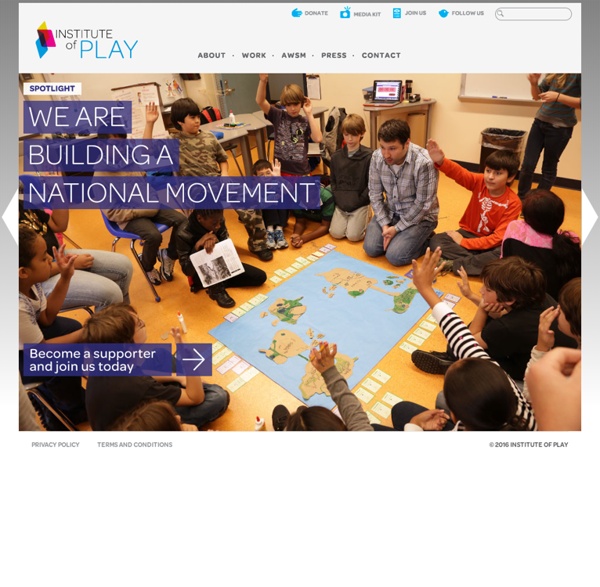



http://www.instituteofplay.org/
Related: New Learning • Ludagogie: école et jeux vidéoTeaching Expert Learners Harrisburg Presentation Resources Here are some resources from my presentation in Harrisburg. Defining and Exploring Gamification from Karl Kapp Here is some additional information. Articles and Blog Entries of Interest 8 Types of Stories to Effect Change Storytelling and Instructional Design Eight Game Elements to Make Learning More Intriguing Games, Gamification and the Quest for Learner Engagement Gamification, […] Continue Reading → 2014 DOE Symposium Conference Resources
What's wrong with educational games (and how we can fix them) I’ve been designing, building, playing and promoting educational games (both digital and non-digital) all my working life. Starting out as a TEFL teacher, games were a huge component of my classes: from number games with little kids to complex role plays with adults. As I began to work more with digital media I started to design games for web and mobile: everything from location-based drawing games to a million-selling multi-level world for kids to learn English.
The Flipped Classroom Model: A Full Picture Due to Khan Academy’s popularity, the idea of the flipped classroom has gained press and credibility within education circles. Briefly, the Flipped Classroom as described by Jonathan Martin is: Flip your instruction so that students watch and listen to your lectures… for homework, and then use your precious class-time for what previously, often, was done in homework: tackling difficult problems, working in groups, researching, collaborating, crafting and creating. Classrooms become laboratories or studios, and yet content delivery is preserved. Flip your instruction so that students watch and listen to your lectures… for homework, and then use your precious class-time for what previously, often, was done in homework: tackling difficult problems, working in groups, researching, collaborating, crafting and creating. Classrooms become laboratories or studios, and yet content delivery is preserved (
What Makes Great Digital Instruction “Digital instruction” (“Boundless”) is delivered via technology, such as video and smart software that offers students a personalized sequence of learning experiences, and does not include live interaction with a teacher. Digital instruction must be combined with an excellent in-person or remotely located teacher, who is personally accountable for students’ learning outcomes. It is “boundless” because, once recorded, great digital instruction can help a limitless number of students located anywhere.
Media and Learning Media & Learning 2014 is the place to be if you are interested in the latest developments, services and uses of media in education and training. Aimed at both policy makers and practitioners, the purpose of this annual event is to identify policies and initiatives that promote digital and media competence at all levels of education and training as well as to promote best-practice in the take-up and application of media in education and training. At this conference we will be discussing: the urgency of embedding digital and media literacy skills amongst the European workforcehow best to convince stakeholders about the importance of embedding digital and media skills amongst learning professionals and learners at all levels of education and training The conference will include:
Some Differences Between Experts and Novices Harrisburg Presentation Resources Here are some resources from my presentation in Harrisburg. Defining and Exploring Gamification from Karl Kapp Here is some additional information. Articles and Blog Entries of Interest 8 Types of Stories to Effect Change Storytelling and Instructional Design Eight Game Elements to Make Learning More Intriguing Games, Gamification and the Quest for Learner Engagement Gamification, […] Continue Reading → 2014 DOE Symposium Conference Resources
Newsmaker: James Gee on Why the Power of Games to Teach Remains Unrealized Gee: “We need to begin to get teams of people — game designers, content people, assessment people, learning people — who can get on the same page.” For more than a decade, James Paul Gee has been writing about the potential power of games and game mechanics to change the way we learn, to create new “deep” learners. But in this newsmaker interview Gee says most of the possibilities of games remain unfulfilled as the American education system continues to focus on tests and fact retention. He worries that even as learning games become more prevalent, they are in danger of being changed by the schools they seek to sell to rather than changing the school itself.
Instructional Strategies Online "What children learn depends not only on what they are taught but also how they are taught, their development level, and their interests and experiences.... These beliefs require that much closer attention be paid to the methods chosen for presenting material..." Understanding the Common Essential Learnings, Saskatchewan Education, 1988. (p.10) "The last decades of research in human learning have presented new insights into the ways that learners are active in constructing their own understanding. Constructivist learning theories have shown the limitations of viewing 'learning' as something we can 'give' to students that they will 'receive' or learn in exactly the same form, at exactly the given time."